Written by
Wilsey YoungSummary: This post is a tutorial that focuses on the Windows 8.1 ISO download (32-bit and 64-bit). This post is also a guide to creating a Windows 8.1 bootable USB via Rufus.
Are you intending to boot an unbootable PC or set up multiple computers with the same configuration? We suggest using iBoysoft DiskGeeker for Windows to clone the Windows 8.1 OS partition instead of creating a bootable USB. -From m3datarecovery.com
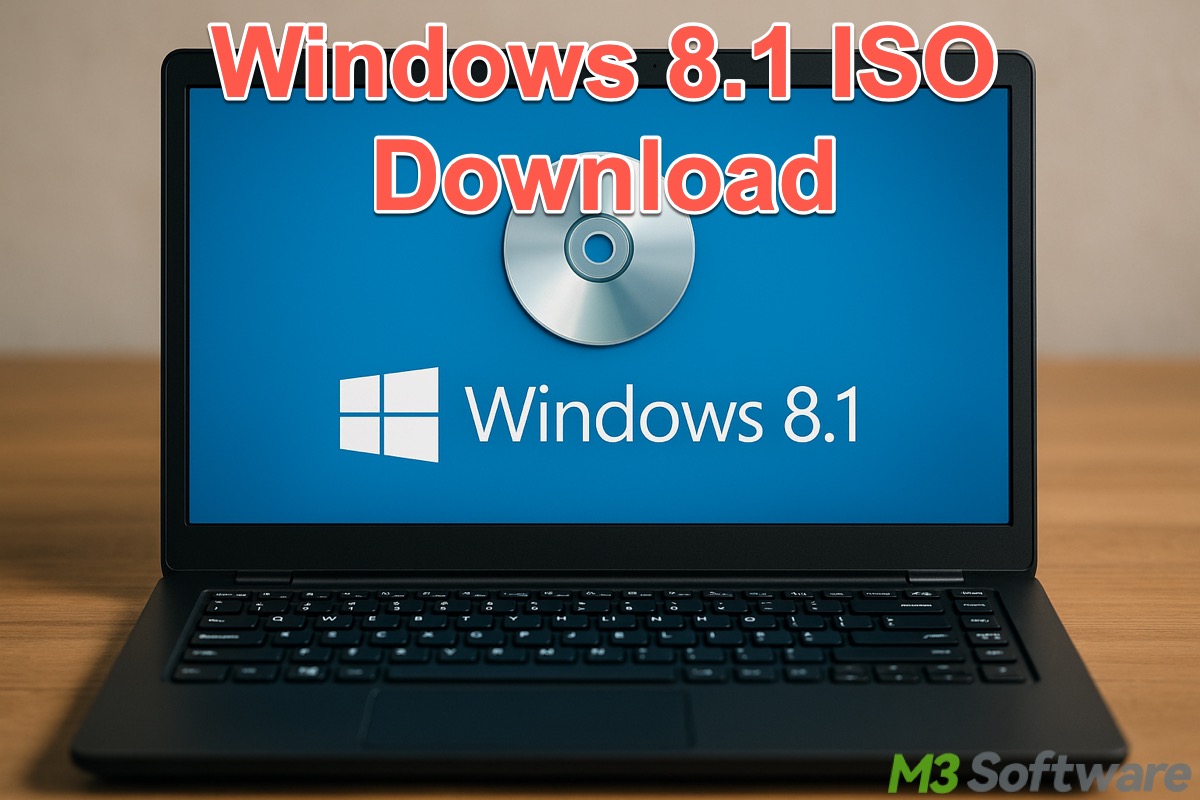
This article primarily introduces the detailed steps to download the Windows 8.1 ISO file, which is not available on Microsoft's site, as official support and updates for Windows 8.1 were terminated in 2023.
Besides the Windows 8.1 ISO download, this post also guides you through the process of creating a Windows 8.1 bootable USB through Rufus, in case you need it.
Before starting, check if your PC and its hardware meet the minimum system requirements for Windows 8.1:
| Processor (CPU) | 1 GHz or faster. Must support PAE, NX, and SSE2 |
| RAM (Memory) | 1 GB for 32-bit; 2 GB for 64-bit |
| Storage | 16 GB for 32-bit; 20 GB for 64-bit |
| Graphics Card | Microsoft DirectX 9 graphics device with WDDM 1.0 driver |
| Secure Boot | UEFI firmware with Secure Boot capability |
Tips: Also need Windows 7? Get it from: Windows 7 Pro ISO Download
If you want to get Windows XP, here it is: Windows XP download
Need Windows Vista ISO? Direct link is here: Windows Vista download
Need to download other Windows ISO files? Follow: Windows ISO Download
Windows 8.1 ISO download (64-bit and 32-bit)
You can download Windows 8.1 ISO (64-bit and 32-bit) by following the steps below:
Note: Archive.org (aka the Internet Archive) is a nonprofit digital library that provides free public access to a massive collection of digital content, including websites, books, videos, software, and more.
- Visit the Archive.org page that provides a secure Windows 8.1 ISO download.
- Tap on the "ISO IMAGE" to expand the download options.
- Click the "Win8.1_English_x32.iso" or Win8.1_English_x64.iso" download link based on your needs.
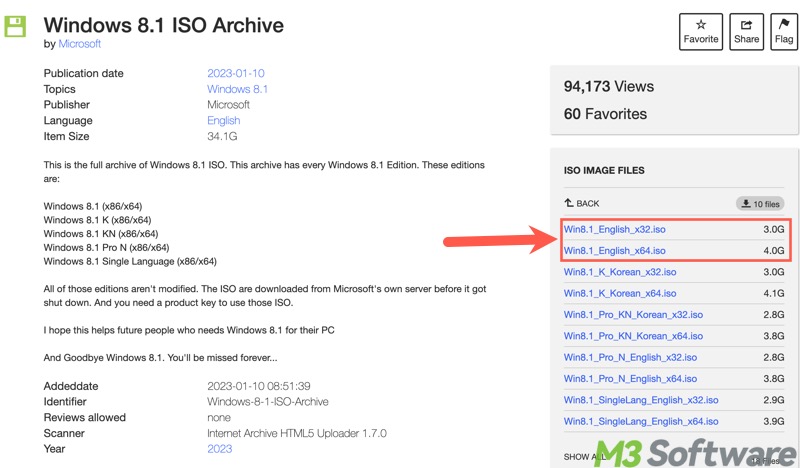
- Wait for the download to complete.
Alternatively, you can click the direct links below for a Windows 8.1 ISO download:
If you only need to install Windows 8.1 (and plan to activate later with a legitimate key), Microsoft publishes generic setup keys (listed below) that allow installation but do not activate Windows.
| Windows 8.1 standard or non-Pro edition | 334NH-RXG76-64THK-C7CKG-D3VPT |
| Windows 8.1 Pro | XHQ8N-C3MCJ-RQXB6-WCHYG-C9WKB |
| Windows 8 Pro with Media Center | GBFNG-2X3TC-8R27F-RMKYB-JK7QT |
You may be interested in Windows 10 ISO download or Windows 11 ISO download
Tap on the buttons below to share the post with your friends
Windows 8.1 Pro ISO download (64-bit and 32-bit)
You can download Windows 8.1 Pro ISO (64-bit and 32-bit) by following the steps below:
- Visit the Archive.org page that offers Windows 8.1 Pro ISO download links.
- Tap on the "ISO IMAGE FILES" to expand the download options.
- Click the "Win8.1_English_x32.iso" or Win8.1_English_x64.iso" download link to start downloading the Windows 8.1 Pro ISO file.
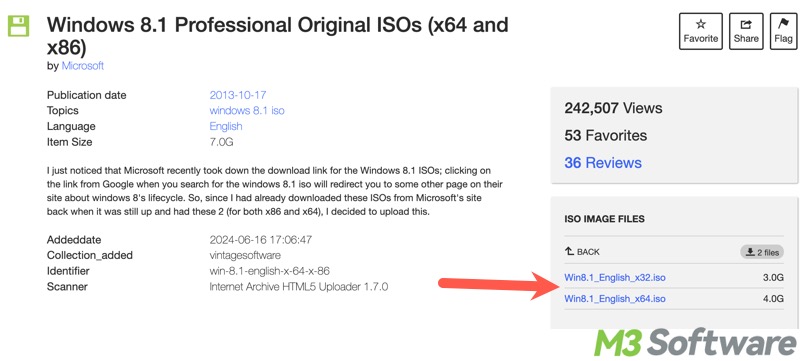
- Wait for the download to complete.
Alternatively, you can click the direct links below for a Windows 8.1 Pro ISO download:
Windows 8.1 All-In-One ISO download
Follow the steps below to download Windows 8.1 All-In-One ISO:
- Visit the Archive.org page that contains Windows 8.1 AIO ISO download links.
- Click the "ISO IMAGE" link under the "DOWNLOAD OPTIONS" section.
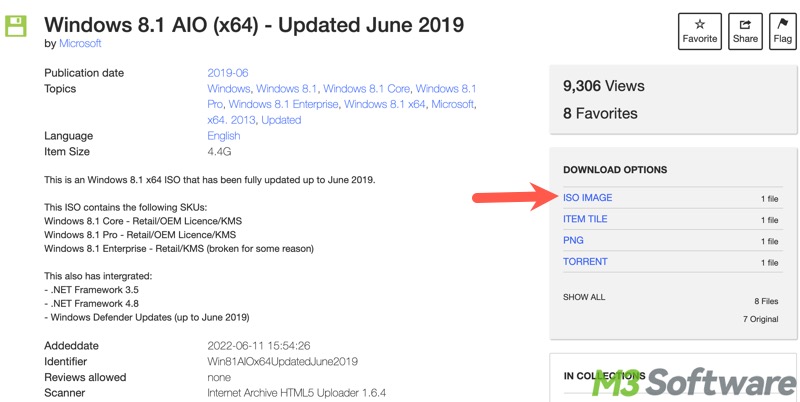
- Wait for the download to complete.
Alternatively, you can click the direct links below for a Windows 8.1 AIO ISO download:
The buttons below help share the post quickly
How to create a Windows 8.1 bootable USB
Generally, users utilize the Windows 8.1 ISO file to install Windows 8.1 OS for various tests, as some older programs, industrial software, or devices, like scanners, printers, or medical tools, only work properly on Windows 8.1 or older versions. In addition, some users want to boot an unbootable PC with older hardware, like limited RAM or outdated drivers, to access its data.
In the cases we mentioned above, you can use iBoysoft DiskGeeker for Windows to clone the OS partition of a Windows 8.1 PC. Eventually, the bootable copy of Windows 8.1 created by this tool can be used to directly start up a computer without any setup or installation.
To clone a Windows 8.1 OS partition via iBoysoft DiskGeeker for Windows:
Note: Ensure the destination disk's free space is larger than that of the OS partition. Back up important files before cloning.
- Download, install, and launch iBoysoft DiskGeeker for Windows on a Windows 8.1 computer.
- Insert an empty USB drive or external hard drive into the Windows 8.1 computer.
- iBoysoft DiskGeeker for Windows automatically detects and selects the Windows 8.1 OS partition before cloning.
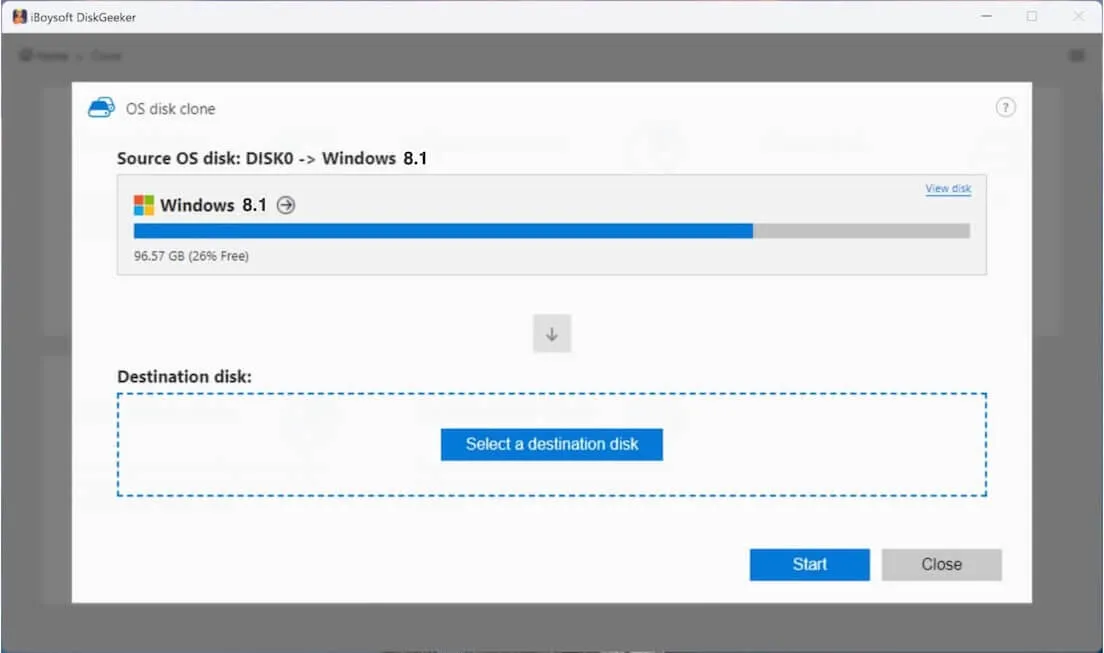
- Tap on the "Select a destination disk" button and select the USB drive or external hard drive you just connected.
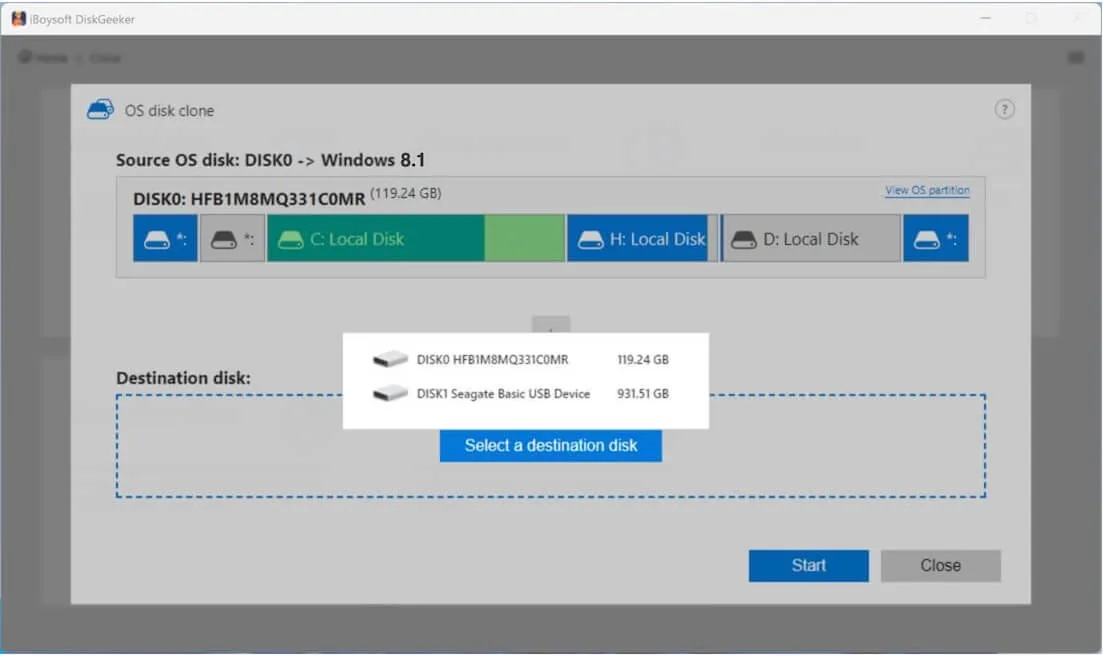
- Click the "Start" and "Confirm" buttons to let the Windows 8.1 OS partition cloning begin.
A bootable copy of Windows 8.1 is ready once the cloning is finished. You can connect this bootable copy of Windows 8.1 to compatible computers for various purposes.
Create a Windows 8.1 bootable USB
If you want to download Windows 8.1 ISO file for a system downgrade, recovery, or clean install, a Windows 8.1 bootable USB is required.
Follow the steps below to create a Windows 8.1 bootable USB through Rufus. Rufus is a free, safe, and open-source utility used to create bootable USB drives.
- Visit Rufus' page to download the Rufus tool.
- Connect a USB with enough free storage space: 32-bit Windows 8.1 requires 16GB, and 64-bit needs 20GB.
- Launch Rufus and select the storage device used to store Windows 8.1 files.
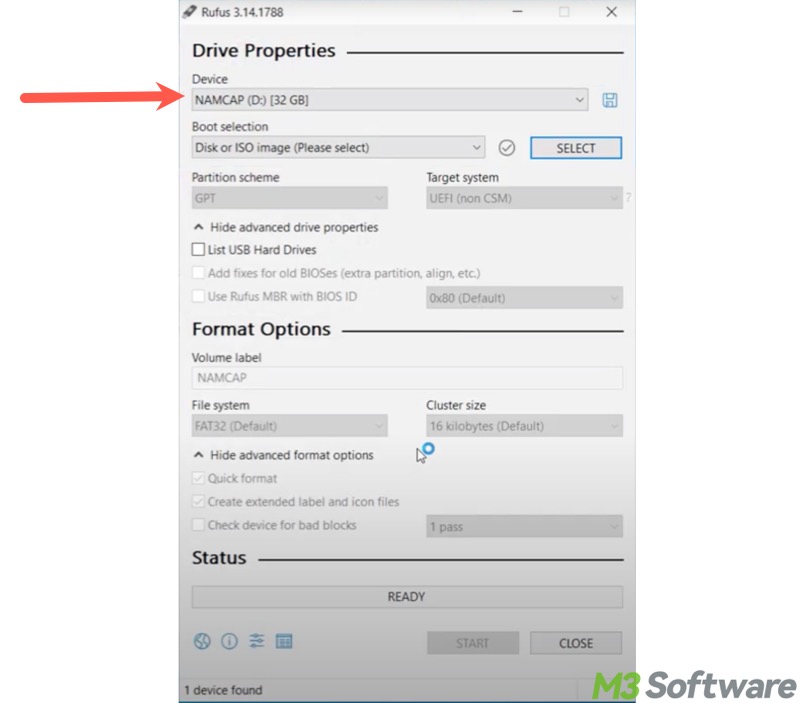
- Tap on the "SELECT" button under the "Boot selection" field, and then choose the downloaded Windows 8.1 ISO file.
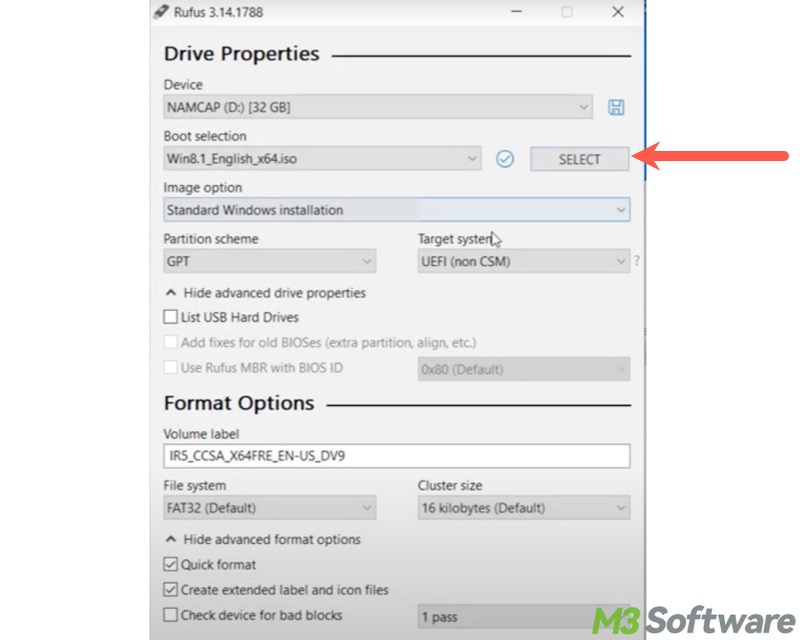
- Regarding "Partition scheme", you can leave it at MBR. But if your PC uses UEFI, select GPT.
- Rename the volume label.
- Click the "START" button.
- When Rufus shows that the Windows 8.1 bootable USB is ready, click "Close."
Now, you can use the Windows 8.1 bootable USB to boot your PC:
- Connect the Windows 8.1 bootable USB to your PC.
- Restart or power on your PC and continuously press the designated key (depending on manufacturer) to enter the BIOS/UEFI menu.
- Navigate to the "Boot" tab.
- Move the target bootable USB device to the top of the boot order list.
- Save changes and exit.
- Follow the instructions to install Windows 8.1.
You can click the following buttons to share the post
FAQs about Windows 8.1 ISO download
No, you don't need a product key to download the Windows 8.1 ISO file, but it requires one during setup. Though the Windows 8.1 setup cannot proceed without a product key, Microsoft publishes generic setup keys that allow installation but do not activate Windows. You can find the official guidance on Microsoft’s support site.
Microsoft ended its support for Windows 8.1 on January 10, 2023, so the Windows 8.1 ISO download options have been officially unavailable since then. The good news is that you can get a Windows 8.1 ISO file from archive.org, which is a reliable nonprofit digital library.
Microsoft’s Media Creation Tool for Windows 8.1 can create a bootable USB drive for Windows 8.1, but only if you use the specific version of the tool designed for Windows 8.1, not the newer Windows 10 or Windows 11 versions.
